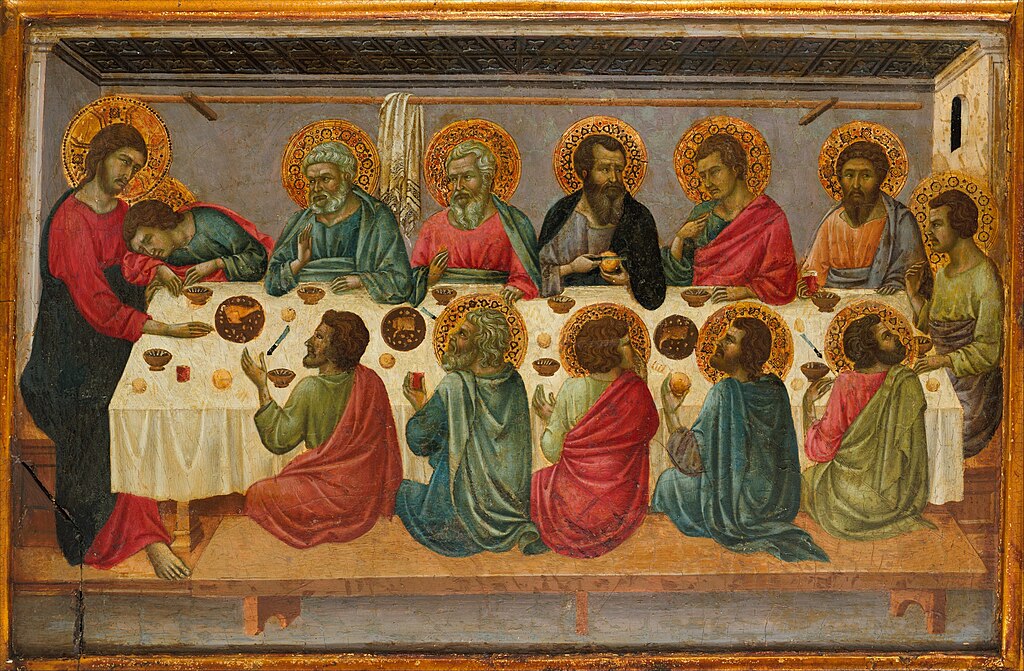
“The Last Supper” by Ugolino di Nerio shows the scene of the Last Supper of Jesus with his apostles, as it is told in the Gospel of John. This painting formed part of the predella, which is the lowermost horizontal part of a dismembered altarpiece.
In this scene, Christ, on the left, informs his disciples that one of them will betray him, a prophecy that was fulfilled by Judas, who is positioned at Christ’s right without a halo.
In this painting, we can also see how Ugolino explored how to paint perspective, as seen with the ceiling and the table settings. Leonardo da Vinci was born over 100 years after this painting was made in Florence.
Ugolino di Nerio
Ugolino di Nerio was a painter active in his native city of Siena and Florence between the years 1317 and 1327. He was a follower of Duccio di Buoninsegna, who is credited with creating the painting styles of the Sienese school, and contributed significantly to the Sienese Gothic style.
Ugolino di Nerio was a leading master who contributed to the spread of Sienese painting in Florence by earning commissions to paint in the two main basilicas there, Santa Maria Novella and Santa Croce.
The Last Supper
The Last Supper is the final meal that Jesus shared with his apostles in Jerusalem before his crucifixion. The First Epistle to the Corinthians contains the earliest known mention of the Last Supper.
The four canonical gospels all state that the Last Supper took place towards the end of the week, after Jesus’s triumphal entry into Jerusalem. Jesus and his apostles shared a meal during which Jesus predicts his betrayal by one of the apostles present.
The Gospels include the account of the institution of the Eucharist in which Jesus takes bread, breaks it, and gives it to others, saying, “This is my body given to you.”
Scholars have looked to the Last Supper as the source of early Christian Eucharistic traditions. Others see the Last Supper’s account as derived from 1st-century eucharistic practice as described later by Paul.
The Last Supper
- Title: The Last Supper
- Artist: Ugolino da Siena (Ugolino di Nerio)
- Date: 1325–30
- Medium: Tempera and gold on wood
- Dimensions: Painted surface 13 1/2 x 20 3/4 in. (34.3 x 52.7 cm)
- Category: Bibilical Art
- Museum: Metropolitan Museum of Art – MET
Ugolino da Siena (Ugolino di Nerio)
- Title: Ugolino da Siena (Ugolino di Nerio)
- Born: 1280 – Siena
- Died: 1349 (age 69) – Siena
- Active in: Siena and Florence
- Nationality: Italian
- Notable Works:
- The Last Supper
A story of blue
A Tour of the Metropolitan Museum of Art – MET
MET European Paintings Collection
- “Pygmalion and Galatea” by Jean-Léon
- “Saint Jerome as Scholar” by El Greco
- “Portrait of Juan de Pareja” by Diego Velázquez
- “Camille Monet on a Garden Bench” by Claude Monet
- “View of Toledo” by El Greco
- “The Musicians” by Caravaggio
- “The Death of Socrates” by Jacques-Louis David
- “The Harvesters” by Pieter Bruegel the Elder
- “Young Woman Drawing” by Marie-Denise Villers
- “The Grand Canal, Venice” by J. M. W. Turner
- “The Houses of Parliament (Effect of Fog)” by Claude Monet
- “Madame Cézanne in a Red Dress” by Paul Cézanne
Tintoretto, Last Supper
- “The Fortune Teller” by Georges de La Tour
- “The Allegory of Faith” by Johannes Vermeer
- “Garden at Sainte-Adresse” by Claude Monet
- “Wheat Field with Cypresses” by Vincent van Gogh
- “The Repast of the Lion” by Henri Rousseau
- “The Horse Fair” by Rosa Bonheur
- “Two Men Contemplating the Moon” by Caspar David Friedrich
- “Boy with a Greyhound” by Paolo Veronese
- “A Windy Day on the Pont des Arts” by Jean Béraud
- “Sunday at the Church of Saint-Philippe-du-Roule, Paris” by Jean Béraud
- “The Boulevard Montmartre on a Winter Morning” by Camille Pissarro
- “The Sorrow of Telemachus” by Angelica Kauffman
MET Medieval Art Collection
- “The Last Supper” by Ugolino di Nerio
- Plaque with the Journey to Emmaus and Noli Me Tangere
- Doorway from the Church of San Nicolò, San Gemini
“The Last Supper” by Ugolino di Nerio
~~~
“Evidently, one cannot look for long at the Last Supper without ceasing to study it as composition and beginning to speak of it as a drama. It is the most literary of all great pictures, one of the few of which the effect may largely be conveyed – can even be enhanced – by description.”
– Kenneth Clark (discussing Leonardo da Vinci’s version)
~~~
Photo Credit: 1) Ugolino di Nerio [Public domain], via Wikimedia Commons
Popular this Week








 Sponsor your Favorite Page
Sponsor your Favorite Page SEARCH Search for: Search Follow UsJoin – The JOM Membership Program
Sponsor a Masterpiece with YOUR NAME CHOICE for $5
Share this:
- Tweet
